用扎根理论对自来水过滤器滤芯清洗的证据进行述评。
IF 3.1
3区 医学
Q1 INFECTIOUS DISEASES
引用次数: 0
摘要
背景:在医院的水龙头/淋浴口安装使用点(POU)过滤器,以应对与水有关的暴发/事件,在患者或供水中分离出水传播病原体,例如铜绿假单胞菌,或作为治疗免疫功能低下患者的高风险地区的预防措施,例如重症监护室或新生儿病房。方法:这篇叙事评论考虑了这些过滤器的外部清洁的证据基础,并采用了一种独特的方法,将扎根理论与标准的叙事评论技术相结合。为了从有限的证据基础中提取相关数据,人们认为这是必要和适当的。结果:没有研究符合纳入叙事评价过程的标准;然而,这里包含的扎根理论为文献中的五个关键主题提供了证据。这些是逆行污染、清洁、维护/培训、系统污染和冲洗/取样。结论:这些主题提供了一个叙事结构,其中讨论了每个主题的证据。然后,轴向编码探索这些主题之间联系的证据。行为方面的影响被提出,同时也有证据表明当前的研究存在缺陷,例如由于临床环境中一系列复杂的变量而导致混淆的重大风险。这种方法整理和定义了与过滤器体污染有关的风险和可能因素,并提供了有关清洁的明确问题,这些问题必须通过进一步的科学研究来回答。本文章由计算机程序翻译,如有差异,请以英文原文为准。
A narrative review with grounded theory to evaluate the evidence for cleaning the filter body of point-of-use tap water filters
Background
Point-of-use filters are installed at tap/shower outlets in hospitals in response to either water-related outbreaks/incidents where water-borne pathogens (e.g. Pseudomonas aeruginosa) have been isolated in a patient or in the water supply, or as a prophylactic measure in areas of high risk where immunocompromised patients are being treated (e.g. intensive care or neonatal units).
Methods
This narrative review considers the evidence base for external cleaning of the body of these filters, and utilizes a unique approach by combining grounded theory with standard narrative review techniques. This was felt necessary and appropriate in order to extract relevant data from a limited evidence base.
Results
No studies met the criteria for inclusion in the narrative review process; however, the inclusion of grounded theory provided evidence of five key themes in the literature: retrograde contamination; cleaning; maintenance/training; system contamination; and flushing/sampling.
Conclusion
These themes provide a narrative structure where the evidence for each theme is discussed. Axial coding explores the evidence for links between these themes. Behavioural implications are raised, as is evidence of flaws in current studies, such as the significant risk of confounding due to a complex range of variables in the clinical setting. This approach has collated and defined the risks and likely factors related to filter body contamination, and provided clear questions regarding cleaning which must be answered through further scientific study.
求助全文
通过发布文献求助,成功后即可免费获取论文全文。
去求助
来源期刊

Journal of Hospital Infection
医学-传染病学
CiteScore
12.70
自引率
5.80%
发文量
271
审稿时长
19 days
期刊介绍:
The Journal of Hospital Infection is the editorially independent scientific publication of the Healthcare Infection Society. The aim of the Journal is to publish high quality research and information relating to infection prevention and control that is relevant to an international audience.
The Journal welcomes submissions that relate to all aspects of infection prevention and control in healthcare settings. This includes submissions that:
provide new insight into the epidemiology, surveillance, or prevention and control of healthcare-associated infections and antimicrobial resistance in healthcare settings;
provide new insight into cleaning, disinfection and decontamination;
provide new insight into the design of healthcare premises;
describe novel aspects of outbreaks of infection;
throw light on techniques for effective antimicrobial stewardship;
describe novel techniques (laboratory-based or point of care) for the detection of infection or antimicrobial resistance in the healthcare setting, particularly if these can be used to facilitate infection prevention and control;
improve understanding of the motivations of safe healthcare behaviour, or describe techniques for achieving behavioural and cultural change;
improve understanding of the use of IT systems in infection surveillance and prevention and control.
 求助内容:
求助内容: 应助结果提醒方式:
应助结果提醒方式:


